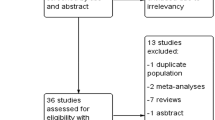Abstract
Purpose
Our aim was to investigate the detrusor muscle sampling rate after monopolar versus bipolar transurethral resection of bladder tumor (TURBT).
Methods
This was a single-center, prospective, randomized, phase III trial on monopolar versus bipolar TURBT. Baseline patient characteristics, disease characteristics and perioperative outcomes were compared, with the primary outcome being the detrusor muscle sampling rate in the TURBT specimen. Multivariate logistic regression analyses on detrusor muscle sampling were performed.
Results
From May 2012 to December 2015, a total of 160 patients with similar baseline characteristics were randomized to receive monopolar or bipolar TURBT. Fewer patients in the bipolar TURBT group required postoperative irrigation than patients in the monopolar TURBT group (18.7 vs. 43%; p = 0.001). In the whole cohort, no significant difference in the detrusor muscle sampling rates was observed between the bipolar and monopolar TURBT groups (77.3 vs. 63.3%; p = 0.057). In patients with urothelial carcinoma, bipolar TURBT achieved a higher detrusor muscle sampling rate than monopolar TURBT (84.6 vs. 67.7%; p = 0.025). On multivariate analyses, bipolar TURBT (odds ratio [OR] 2.23, 95% confidence interval [CI] 1.03–4.81; p = 0.042) and larger tumor size (OR 1.04, 95% CI 1.01–1.08; p = 0.022) were significantly associated with detrusor muscle sampling in the whole cohort. In addition, bipolar TURBT (OR 2.88, 95% CI 1.10–7.53; p = 0.031), larger tumor size (OR 1.05, 95% CI 1.01–1.10; p = 0.035), and female sex (OR 3.25, 95% CI 1.10–9.59; p = 0.033) were significantly associated with detrusor muscle sampling in patients with urothelial carcinoma.
Conclusions
There was a trend towards a superior detrusor muscle sampling rate after bipolar TURBT. Further studies are needed to determine its implications on disease recurrence and progression.

Similar content being viewed by others
References
Herr HW. Early history of endoscopic treatment of bladder tumors from Grunfeld’s polypenkneipe to the Stern-McCarthy resectoscope. J Endourol. 2006;20:85–91.
Brauers A, Buettner R, Jakse G. Second resection and prognosis of primary high risk superficial bladder cancer: is cystectomy often too early? J Urol. 2001;165:808–810.
Miladi M, Peyromaure M, Zerbib M, Saighi D, Debre B. The value of a second transurethral resection in evaluating patients with bladder tumours. Eur Urol. 2003;43:241–245.
Sylvester RJ, van der Meijden AP, Oosterlinck W, Witjes JA, Bouffioux C, Denis L, et al. Predicting recurrence and progression in individual patients with stage Ta T1 bladder cancer using EORTC risk tables: a combined analysis of 2596 patients from seven EORTC trials. Eur Urol. 2006;49:466–477; discussion 475–467.
Herr HW, Donat SM. Quality control in transurethral resection of bladder tumours. BJU Int. 2008;102:1242–1246.
Herr HW. The value of a second transurethral resection in evaluating patients with bladder tumors. J Urol. 1999;162:74–76.
Mariappan P, Zachou A, Grigor KM, Edinburgh Uro-Oncology Group. Detrusor muscle in the first, apparently complete transurethral resection of bladder tumour specimen is a surrogate marker of resection quality, predicts risk of early recurrence, and is dependent on operator experience. Eur Urol. 2010;57:843–849.
Shindo T, Masumori N, Kitamura H, Tanaka T, Fukuta F, Hasegawa T, et al. Clinical significance of definite muscle layer in TUR specimen for evaluating progression rate in T1G3 bladder cancer: multicenter retrospective study by the Sapporo Medical University Urologic Oncology Consortium (SUOC). World J Urol. 2014;32:1281–1285.
Singh H, Desai MR, Shrivastav P, Vani K. Bipolar versus monopolar transurethral resection of prostate: randomized controlled study. J Endourol. 2005;19:333–338.
Wang DS, Bird VG, Leonard VY, Plumb SJ, Konety B, Williams RD, et al. Use of bipolar energy for transurethral resection of bladder tumors: pathologic considerations. J Endourol. 2004;18:578–582.
Cui Y, Chen H, Liu L, Chen J, Qi L, Zu X. Comparing the efficiency and safety of bipolar and monopolar transurethral resection for non-muscle invasive bladder tumors: a systematic review and meta-analysis. J Laparoendosc Adv Surg Tech A. 2016;26:196–202.
Del Rosso A, Pace G, Masciovecchio S, Saldutto P, Galatioto GP, Vicentini C. Plasmakinetic bipolar versus monopolar transurethral resection of non-muscle invasive bladder cancer: a single center randomized controlled trial. Int J Urol. 2013;20:399–403.
Venkatramani V, Panda A, Manojkumar R, Kekre NS. Monopolar versus bipolar transurethral resection of bladder tumors: a single center, parallel arm, randomized, controlled trial. J Urol. 2014;191:1703–1707.
Maruniak NA, Takezawa K, Murphy WM. Accurate pathological staging of urothelial neoplasms requires better cystoscopic sampling. J Urol. 2002;167:2404–2407.
Dalbagni G, Herr HW, Reuter VE. Impact of a second transurethral resection on the staging of T1 bladder cancer. Urology. 2002;60:822–824; discussion 824–825.
Acknowledgements
The authors would like to thank Ms. Lam Nga-Yee, Ms. Luke Yip, and Mr. Leung Chi-Ho for their assistance in patient recruitment, data collection, and analysis process.
Conflict of interest
Jeremy Yuen-Chun Teoh, Eddie Shu-Yin Chan, Siu-Ying Yip, Ho-Man Tam, Peter Ka-Fung Chiu, Chi-Hang Yee, Hon-Ming Wong, Chi-Kwok Chan, Simon See-Ming Hou, and Chi-Fai Ng have no conflicts of interest to declare.
Author information
Authors and Affiliations
Corresponding author
Rights and permissions
About this article
Cite this article
Teoh, J.YC., Chan, E.SY., Yip, SY. et al. Comparison of Detrusor Muscle Sampling Rate in Monopolar and Bipolar Transurethral Resection of Bladder Tumor: A Randomized Trial. Ann Surg Oncol 24, 1428–1434 (2017). https://doi.org/10.1245/s10434-016-5700-7
Received:
Published:
Issue Date:
DOI: https://doi.org/10.1245/s10434-016-5700-7




